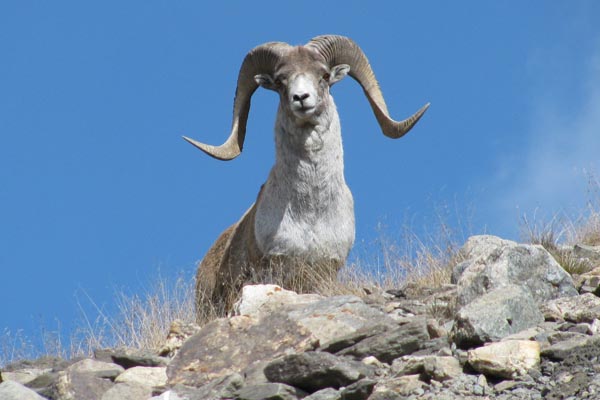TIBETAN ARGALI
Ovis ammon hodgsoni
Physical Description
The Argali, or the Asian Wild Sheep, is the largest species of wild sheep in the world. The Tibetan Argali is one of the eight recognized subspecies of the Argali. The Tibetan Argali has light grayish brown upper parts that are darker along the back, a white belly, and a white rump patch. The white rump patch surrounds the Tibetan Argali’s black-tipped tail, which, at less than six centimetres (2.4 inches) long, is the shortest tail of the Argali sub-species.
A stripe runs along the side of the Tibetan Argali’s body, separating the light belly from the darker upper parts. During the winter, the contrast between the light and dark parts of the Tibetan Argali’s body becomes more pronounced. The lateral stripe darkens in color, and the backs of the legs, the face, and the male’s neck ruff turn white.
The Argali has very large, corkscrew-like horns that grow throughout the sheep’s life. The horns of Tibetan Argali rams are ridged and the horn tips, which point forwards and sometimes outwards, are usually broken or splintered.
The longest horns of a male Tibetan argali that have been measured were 145 centimetres (4.8 feet) long. The horns of female Tibetan argalis are significantly smaller and shorter than those of the males.
The longest horns of a female Tibetan argali that have been measured were 46 centimetres (1.5 feet) long. The Tibetan Argali has a compact body and long legs. Tibetan Argali rams stand about 118 centimetres (3.9 feet) tall at the shoulder and weigh an average of 105 kilograms (231 pounds). Females stand 104 to 112 centimetres (3.4 to 3.7 feet) at the shoulder and weigh only about 68 kilograms (150 pounds).
Habitat
The Argali predominately inhabits high plateaus, rolling hills, and relatively gentle mountain slopes, at elevations from 3,000 to 5,000 metres (10,000 to 16,500 feet). The Tibetan Argali is found throughout the Tibetan Plateau, including regions of Nepal and Sikkim and Ladakh in India that are close to the Tibetan border. In the winter, the Argali tends to migrate to lower elevations or to less snowy areas.
Eating Habits
The Tibetan Argali forages on grasses, herbs, sedges, and shrubs.
Behaviour and Reproduction
The Tibetan Argali usually forms small herds, of 2 to 15 sheep, but groups as large as 50 have been spotted. Adult rams tend to commingle with females only during the rut season. During the rest of the year, they live in separate all-male herds. The Argali’s primary vocalizations are an alarm whistle and a warning hiss, which the sheep produces by blowing air through its nostrils.
Female argalis reach sexual maturity at two years of age, while males reach sexual maturity at five years of age. The rut occurs between November and January. During the rut, competing rams fight by rearing up on their hind legs, leaning forward, and racing towards each other, crashing horns upon impact. The Tibetan Argali’s gestation period is 150 to 160 days long. Pregnant females separate from the herd and retreat to protected areas. Births take place in late May and early June. Each mother gives birth to one lamb, or, very rarely, to twins. The mother and her newborn lamb remain separated from the herd for several days, during which the mother takes brief forays to graze, while the newborn mostly lays motionless.
The Tibetan Argali rarely lives beyond 9 years of age. The Argali evades its predators, which include wolves and snow leopards, by fleeing or by taking refuge on steep mountain slopes. The Tibetan Argali is a relatively fast runner.
Present Status
The Tibetan Argali is categorized as Vulnerable in the 2003 IUCN Red List of Threatened Species and is listed under Appendix I of CITES. The Tibetan Argali is under second class protection in China. and is included in Schedule I, Part I of the Indian (Wildlife) Protection Act, 1972. In 1998, noted zoologist Schaller estimated that the total population size of the Tibetan Argali could be as low as 7,000. The Tibetan Argali’s population is fragmented and is declining.
Threats to Survival
The Tibetan Argali was traditionally hunted for food on a subsistence basis, but has been increasingly hunted for its horns. The horns are of value to trophy hunters and may also be used in traditional Chinese medicine. Another serious threat to the Argali’s survival are the increasingly large livestock populations encroaching upon large sections of the Argali’s habitat range. Argalis in these regions are forced to compete with livestock for habitat, forage, minerals, and water.
References
Caprinae Specialist Group, 1996: Ovis ammon. In: IUCN, 2003: 2003 IUCN Red List of Threatened Species, http://www.redlist.org, Aug 2004.
Sathyakumar, S. and Bhatnagar, Y.V., “Mountain Ungulates,” Wildlife and Protected Areas, Vol. 1, No. 1, Dec 2002, http://www.wii.gov.in/
envis/ungulates/chapter2.htm, Aug 2004.
Schaller, George B., 1998: Wildlife of the Tibetan Steppe, The University of Chicago Press, London, 80pp.
By: Environment and Development Desk, DIIR, CTA.



comment 0